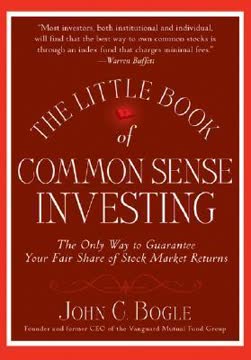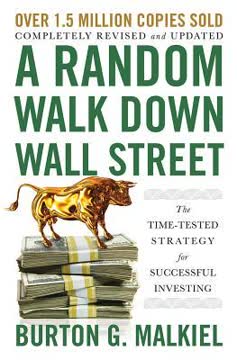Key Takeaways
1. Start Saving Early and Consistently for Financial Security
"The fast way to affluence is simple: Reduce your expenses well below your income—and Shazam!—you are affluent because your income exceeds your outgo."
Pay yourself first. The foundation of financial security is consistent saving. Begin as early as possible, even if the amounts are small. Automate your savings by setting up regular contributions to investment accounts. This habit ensures you're building wealth steadily over time.
Live below your means. Cultivate a mindset of frugality and conscious spending. Differentiate between needs and wants, and prioritize long-term financial goals over short-term gratification. Consider using techniques like:
- Creating a detailed budget
- Tracking expenses meticulously
- Finding creative ways to reduce costs without sacrificing quality of life
- Avoiding lifestyle inflation as your income grows
Remember, it's not about deprivation, but about making intentional choices that align with your financial goals.
2. Embrace the Power of Compound Interest
"The secret of getting rich slowly but surely is the miracle of compound interest."
Time is your greatest ally. Compound interest allows your money to grow exponentially over time. The earlier you start investing, the more time your money has to compound, potentially leading to significant wealth accumulation.
Understand the Rule of 72. This simple formula helps you estimate how long it will take for your investment to double:
- Divide 72 by your expected annual return rate
- The result is the approximate number of years for your investment to double
For example:
- At 7% annual return, your investment doubles in about 10 years (72 ÷ 7 = 10.3)
- At 10% annual return, it doubles in about 7 years (72 ÷ 10 = 7.2)
This rule illustrates why starting early and earning even slightly higher returns can have a dramatic impact on your long-term wealth.
3. Diversify Your Investment Portfolio Broadly
"Diversify across securities, across asset classes, across markets—and across time."
Spread your risk. Diversification is a key strategy for managing investment risk. By spreading your investments across different asset classes, sectors, and geographic regions, you can reduce the impact of poor performance in any single area.
Key diversification strategies:
- Asset classes: Mix stocks, bonds, real estate, and potentially commodities
- Geographic regions: Invest in both domestic and international markets
- Company sizes: Include large-cap, mid-cap, and small-cap stocks
- Sectors: Spread investments across various industries
- Time: Use dollar-cost averaging to invest regularly over time
Remember, diversification doesn't guarantee profits or protect against losses, but it can help manage risk and potentially improve returns over the long term.
4. Choose Low-Cost Index Funds for Long-Term Success
"Nobody knows more than the market."
Embrace market efficiency. The collective wisdom of all market participants is incredibly difficult to beat consistently. Instead of trying to outsmart the market, aim to capture its overall returns through low-cost index funds.
Benefits of index funds:
- Low fees: Typically charge much less than actively managed funds
- Broad diversification: Automatically spread risk across many securities
- Tax efficiency: Less frequent trading leads to fewer taxable events
- Simplicity: Easy to understand and manage
Research consistently shows that most actively managed funds underperform their benchmark indexes over long periods, especially after accounting for fees. By choosing low-cost index funds, you're positioning yourself to capture market returns while minimizing costs and complexity.
5. Avoid Common Investing Mistakes and Emotional Decisions
"As human beings, we like to be told what the future will bring. Soothsayers and astrologists have made forecasts throughout history."
Control your emotions. Many investing mistakes stem from emotional reactions to market movements or attempts to time the market. Recognize common psychological biases that can lead to poor decisions:
- Overconfidence: Believing you can consistently beat the market
- Herd mentality: Following the crowd into popular investments
- Recency bias: Giving too much weight to recent events
- Loss aversion: Fearing losses more than valuing equivalent gains
Strategies to avoid these pitfalls:
- Develop a long-term investment plan and stick to it
- Ignore short-term market noise and predictions
- Avoid checking your portfolio too frequently
- Use automatic investments to remove emotion from the process
- Educate yourself about behavioral finance to recognize your own biases
Remember, successful investing is often about patience and discipline rather than trying to outsmart the market.
6. Rebalance Your Portfolio Annually
"Rebalancing simply means that periodically, such as once a year, you look at the asset allocation of your portfolio and bring it back into the kind of balance that makes you comfortable."
Maintain your target allocation. Over time, different parts of your portfolio will perform differently, causing your asset allocation to drift from your original plan. Annual rebalancing helps you maintain your desired risk level and can potentially improve returns.
Rebalancing process:
- Review your current asset allocation
- Compare it to your target allocation
- Sell overweight assets and buy underweight assets to realign
Benefits of rebalancing:
- Keeps your portfolio aligned with your risk tolerance
- Forces you to buy low and sell high
- Helps maintain diversification
- Provides a systematic approach to portfolio management
Consider using threshold rebalancing, where you rebalance when an asset class deviates by a certain percentage (e.g., 5%) from its target allocation, rather than on a fixed schedule.
7. Utilize Tax-Advantaged Retirement Accounts
"Because the U.S. government wants to encourage us to save more, a variety of retirement plans are available that allow individual taxpayers to deduct from their federal taxes every dollar they save."
Maximize tax benefits. Take full advantage of tax-advantaged retirement accounts to boost your savings and investment returns. These accounts offer benefits like tax-deductible contributions, tax-free growth, or tax-free withdrawals in retirement.
Key retirement accounts to consider:
- 401(k) or 403(b): Employer-sponsored plans with potential matching contributions
- Traditional IRA: Tax-deductible contributions and tax-deferred growth
- Roth IRA: After-tax contributions with tax-free growth and withdrawals
- SEP IRA or Solo 401(k): Options for self-employed individuals
Prioritize contributions in this order:
- Contribute enough to your 401(k) to get full employer match
- Max out IRA contributions (choose between Traditional and Roth based on your situation)
- Max out 401(k) contributions
- Consider additional taxable investments if you've maxed out retirement accounts
Remember to review contribution limits annually, as they may change over time.
8. Adapt Your Investment Strategy as You Age
"The appropriate allocation for individual investors depends upon a few key factors. The primary factor is age."
Adjust risk over time. As you move through different life stages, your investment strategy should evolve to match your changing goals, time horizon, and risk tolerance. Generally, younger investors can afford to take on more risk, while those closer to retirement should focus on capital preservation.
General asset allocation guidelines by age:
- 20s-30s: 90-100% stocks
- 40s-50s: 80-90% stocks, 10-20% bonds
- 60s: 70-80% stocks, 20-30% bonds
- 70s: 60-70% stocks, 30-40% bonds
- 80s and beyond: 50-60% stocks, 40-50% bonds
These are just guidelines; your personal situation may warrant different allocations. Consider factors like:
- Your risk tolerance
- Other sources of income (e.g., pensions)
- Overall financial situation
- Health and life expectancy
- Legacy goals
Regularly review and adjust your investment strategy to ensure it remains aligned with your evolving needs and circumstances.
9. Stay the Course During Market Volatility
"When everyone around you is losing his or her head, just stand there and do nothing. Keep your eyes and your mind focused on the long term."
Maintain perspective. Market volatility is normal and inevitable. Short-term fluctuations, even severe ones, don't negate the long-term upward trend of markets. By staying invested through turbulent times, you position yourself to capture the eventual recovery.
Strategies for navigating market volatility:
- Reframe your perspective: View market declines as opportunities to buy at lower prices
- Avoid media hype: Limit exposure to sensationalist financial news
- Review your asset allocation: Ensure it aligns with your risk tolerance and time horizon
- Continue regular investments: Use dollar-cost averaging to potentially benefit from lower prices
- Focus on your goals: Remember why you're investing and your long-term objectives
If market volatility causes significant stress, it may be a sign that your asset allocation is too aggressive for your risk tolerance. Consider adjusting your portfolio to a more comfortable level of risk, but avoid making drastic changes based on short-term market movements.
Last updated:
FAQ
What's "The Elements of Investing" about?
- Purpose: "The Elements of Investing" by Burton G. Malkiel and Charles D. Ellis is a guide to personal finance and investing, aimed at providing easy-to-understand lessons for every investor.
- Content: The book distills the authors' extensive experience into a sensible plan for saving and investing, focusing on simplicity and practicality.
- Structure: It covers topics such as saving, index funds, diversification, avoiding investment blunders, and keeping investment strategies simple.
- Audience: It is intended for both new and seasoned investors, offering timeless advice that can be applied throughout one's investing journey.
Why should I read "The Elements of Investing"?
- Simplicity: The book offers straightforward, jargon-free advice that is accessible to all levels of investors.
- Proven Strategies: It provides time-tested strategies that have helped millions achieve financial success.
- Comprehensive Guidance: From saving to investing in retirement, the book covers all essential aspects of personal finance.
- Expert Authors: Written by renowned investment experts, the book distills decades of experience into practical advice.
What are the key takeaways of "The Elements of Investing"?
- Start Saving Early: The book emphasizes the importance of saving early and regularly to take advantage of compound interest.
- Index Funds: It advocates for investing in low-cost index funds as a way to achieve market returns without the high fees of active management.
- Diversification: Diversifying across asset classes, markets, and time is crucial to reducing investment risk.
- Avoiding Mistakes: The book highlights common investment blunders and how to avoid them, such as overconfidence and market timing.
What is the Rule of 72 mentioned in "The Elements of Investing"?
- Definition: The Rule of 72 is a simple formula used to estimate the number of years required to double an investment at a fixed annual rate of return.
- Formula: Divide 72 by the annual rate of return to get the approximate number of years needed to double the investment.
- Example: At an 8% return, it takes approximately 9 years to double your money (72 divided by 8).
- Application: This rule helps investors understand the power of compounding and the importance of starting early.
How does "The Elements of Investing" suggest you diversify your investments?
- Across Asset Classes: Diversify by holding a mix of stocks, bonds, and real estate to spread risk.
- Across Markets: Include international investments to benefit from global economic growth and reduce reliance on any single market.
- Over Time: Use dollar-cost averaging to invest regularly over time, reducing the risk of market timing.
- Broad Index Funds: Invest in broad-based index funds to achieve diversification with minimal effort and cost.
What are the benefits of index funds according to "The Elements of Investing"?
- Low Costs: Index funds typically have lower management fees compared to actively managed funds, increasing net returns.
- Market Returns: They aim to replicate market performance, providing consistent returns over time.
- Tax Efficiency: With less frequent trading, index funds often generate fewer taxable events, benefiting investors in taxable accounts.
- Simplicity: They offer a straightforward way to invest in a diversified portfolio without the need for constant monitoring.
What mistakes should investors avoid according to "The Elements of Investing"?
- Overconfidence: Believing you can consistently beat the market can lead to risky and costly investment decisions.
- Market Timing: Attempting to predict market movements often results in buying high and selling low.
- High Costs: Paying high fees for active management can significantly reduce investment returns over time.
- Ignoring Diversification: Failing to diversify can expose your portfolio to unnecessary risk and volatility.
How does "The Elements of Investing" recommend you approach asset allocation?
- Age-Based Allocation: Adjust your asset mix based on your age, with more stocks when young and more bonds as you approach retirement.
- Risk Tolerance: Consider your comfort with market fluctuations when determining your stock-bond allocation.
- Rebalancing: Periodically adjust your portfolio to maintain your desired asset allocation, especially after significant market movements.
- Personal Circumstances: Tailor your allocation to your financial situation, goals, and investment horizon.
What is the KISS investing strategy in "The Elements of Investing"?
- Keep It Simple, Sweetheart: Focus on simple, straightforward investment strategies that are easy to understand and implement.
- Index Funds: Use low-cost index funds for broad market exposure and diversification.
- Regular Saving: Emphasize the importance of saving regularly and starting early to build wealth over time.
- Long-Term Focus: Ignore short-term market fluctuations and stay committed to your investment plan.
What are the best quotes from "The Elements of Investing" and what do they mean?
- "The secret of getting rich slowly but surely is the miracle of compound interest." This highlights the power of compounding and the importance of starting to save early.
- "Nobody knows more than the market." This emphasizes the efficiency of markets and the difficulty of consistently outperforming them.
- "Diversify, Diversify, Diversify." A reminder of the importance of spreading investments across different asset classes to reduce risk.
- "Minimize your investment costs." A fundamental principle that underscores the impact of fees on long-term investment returns.
How does "The Elements of Investing" address investing during volatile times?
- Stay the Course: The book advises against making impulsive decisions based on short-term market volatility.
- Rebalancing: Use market fluctuations as an opportunity to rebalance your portfolio and maintain your desired asset allocation.
- Dollar-Cost Averaging: Continue investing regularly to take advantage of lower prices during market downturns.
- Focus on Long-Term Goals: Keep your investment strategy aligned with your long-term financial objectives, regardless of market conditions.
What is the significance of the "Confession" section in "The Elements of Investing"?
- Honesty: The authors share their personal investment experiences, acknowledging that even experts can have biases and make mistakes.
- Real-Life Examples: They illustrate how personal preferences and emotions can influence investment decisions.
- Indexing Core Investments: Despite personal stock picks, the authors emphasize that their core retirement funds are safely indexed.
- Learning from Mistakes: The section serves as a reminder that disciplined investing and sticking to proven strategies are crucial for success.
Review Summary
The Elements of Investing receives mostly positive reviews, praised for its concise, straightforward advice on basic investing principles. Readers appreciate its focus on index funds, diversification, and long-term strategies. Many find it ideal for beginners or those seeking a refresher. Some criticize its simplicity, repetitiveness, and US-centric approach. The book emphasizes saving early, avoiding debt, and using low-cost index funds. While experienced investors may find little new information, many recommend it as an essential read for those starting their investment journey.
Similar Books










Download PDF
Download EPUB
.epub digital book format is ideal for reading ebooks on phones, tablets, and e-readers.





